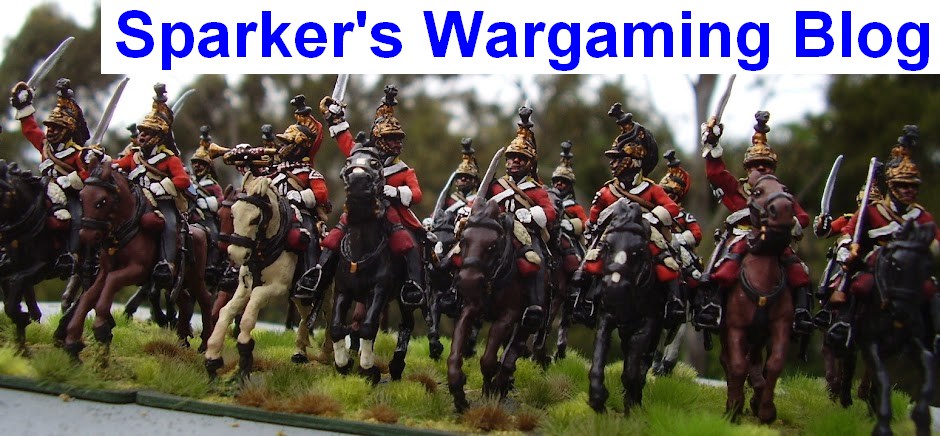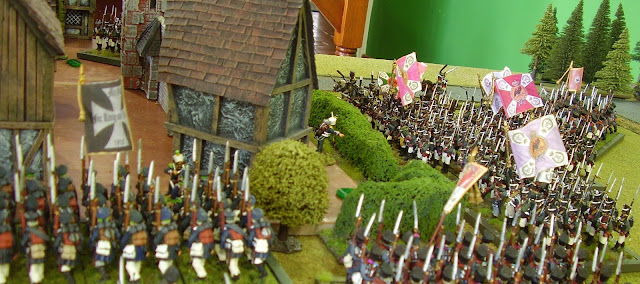 |
| 20mm Post war gaming - 3rd Shock Army goes West - Skytrex BRDM, Brittannia BMP, Hobbymaster T55. Too big a scale for the tabletop? |
 A real stumbling block has been the dearth of Post War, 1980's era British Infantry, armed with the distinctive SLR, which is a long, slender weapon with a very narrow barrel and muzzle arrangement. It has only been very recently that good models have appeared in 28mm scale, and 20mm scale. However, deep down, I know that the speed and ranges involved in modern armoured warfare suggest that 15mm models are at the very upper limit of scale for my 12' x 6' table.... So it was with very great interest that I picked up from TMP that QRF were going to revamp their earlier Post War British Infantry, which, as an Opeval assessment would bluntly put it, were 'Unsatisfactory', at least to my critical eye...
A real stumbling block has been the dearth of Post War, 1980's era British Infantry, armed with the distinctive SLR, which is a long, slender weapon with a very narrow barrel and muzzle arrangement. It has only been very recently that good models have appeared in 28mm scale, and 20mm scale. However, deep down, I know that the speed and ranges involved in modern armoured warfare suggest that 15mm models are at the very upper limit of scale for my 12' x 6' table.... So it was with very great interest that I picked up from TMP that QRF were going to revamp their earlier Post War British Infantry, which, as an Opeval assessment would bluntly put it, were 'Unsatisfactory', at least to my critical eye... |
| FN SLR L1AI - Does it slim muzzle push the enevelope of 15mm scale scultping techniques? |
I should stress that all of these reviews photos are posted quite literally 'straight out of the bag' - indeed, my order from QRF has yet to fully arrive, I am missing several packs, but the parcel was marked 1 of 2, so I am hoping that the rest of my order is still in the tender hands of Australia Post! There is some some flash, mainly along the bottom of the bases, and some on the muzzles. It all looks as if will clean off fairly easily, and, like all white metal sculpts, would benefit from a gentle going over with a brass brush before undercoating.
The poses are well thought out, and in the case of the advancing figures, nicely dynamic.
The berets, to the modern eye, are quite voluminous, but then they were in the 70's, and at least the effort has been made to sculpt them with the fullness pulled to one side, rather than the 'dustbin' look that so distinguishes the raw recruit.
The webbing is accurate, '58 Pattern', as you would expect, although the 'bum roll' is worn under the kidney pouches, as regulations demand, rather than above them as was the norm if all the NBCD 'noddy suit' gear was to fit into it and allow any sort of running gait...
My only real beef is with the SLR itself, the look and heft of the weapon has not really been captured, to my mind, and the muzzle is absent from about a third of the figures I recieved in 2 packs of 8. But can anything better be reasonably expected, in this scale. I doubt it! Perhaps I shall be in for a pleasant surprise when the 'skin lid' figures with the '44 pattern steel helmet come out soon...So the assessment for the infantry so far - 'Just Satisfactory'!
I also benefitted from the recent QRF sale to purchase some Milan teams, not expected in the Post War version, so with SA80 as modern troops. Absolutely no reservations at all about these chaps. I will say that the muscle bosun heaving the spare around must have had his weetabix that morning as these things weighed a ton, at least the sand filled empties that we had to lug around in 'A' Company 2 Wessex! These chaps rate a 'Very Satisfactory'.
Now a note of apology creeps into my commentary as I discuss another purchase, the QRF Stillbrew Chieftain MBT:
Repeating that these are straight out of the box, this model was a thing of beauty that really does capture the look and feel of the real thing, unlike what I have said previously about the QRF model of the early Mk of Chieftain. The track detail, no, all the detail, is crisp and clear and looks to fit together well.
 |
| QRF Chieftain STILLBREW - My imaginary Inspecting Staff award this a 'Good' |
 I
I t seems as if just about every arm of service and regiment in BAOR employed these as general runabouts, and why wouldn't you - fast, easy to maintain, a Browning MG and a bit of armour. Once again I do feel that QRF have captured the feel of the original, another 'Good!'. The model pictured is the Mark 4, whereas I think this photo is of a Mark 3, but hopefully you get my point:
t seems as if just about every arm of service and regiment in BAOR employed these as general runabouts, and why wouldn't you - fast, easy to maintain, a Browning MG and a bit of armour. Once again I do feel that QRF have captured the feel of the original, another 'Good!'. The model pictured is the Mark 4, whereas I think this photo is of a Mark 3, but hopefully you get my point:
QRF of course, are the pioneers of 15mm Modern AFV modelling, I well remember a chat at a Southern Militaire show with Mick Bliss, RTR, around 1990, when his T80 model caused quite a stir! Mick's 'FEBA' rules are amongst the front runners of rules I will consider using for this era, whenever time allows for trials...
The other brace of AFV's I ordered from QRF may seem surprising, if I am wargaming a
 Cold War Gone Hot scenario for around 1983-85, but I have it on good authority that, officially obsolescent, the Saladin 6 wheel armoured car would have been deployed by the TAVR Regiments of the Royal Yeomanry and the Queen's Own Yeomanry around this time, in the Battle Group recce role, albeit not for an armoured, division, but what the hey, these cats are just too cool to leave out of the party!
Cold War Gone Hot scenario for around 1983-85, but I have it on good authority that, officially obsolescent, the Saladin 6 wheel armoured car would have been deployed by the TAVR Regiments of the Royal Yeomanry and the Queen's Own Yeomanry around this time, in the Battle Group recce role, albeit not for an armoured, division, but what the hey, these cats are just too cool to leave out of the party! Now with this model, were I have literally just popped the hull onto the wheels, which like all the wheeled vehicles I have seen from QRF so far come with the wheels in pairs joined by the axle, I do think I am going to need to do a little work on the axle and wheels to get it looking kosher. Assessment - 'Very Satisfactory'.You may recall that in Gulf War 1 a few of these wielded by a handful of courageous Kuwaitis played havoc with a column of invading Iraqui T-72s in KC for quite some time - they have a useful HEAT round.
Now with this model, were I have literally just popped the hull onto the wheels, which like all the wheeled vehicles I have seen from QRF so far come with the wheels in pairs joined by the axle, I do think I am going to need to do a little work on the axle and wheels to get it looking kosher. Assessment - 'Very Satisfactory'.You may recall that in Gulf War 1 a few of these wielded by a handful of courageous Kuwaitis played havoc with a column of invading Iraqui T-72s in KC for quite some time - they have a useful HEAT round. Now with all this fine British post war armour and infantry, my Soviet hordes, mainly furnished by Skytrex and Peter Pig - perhaps more anon - will be hard pressed to punch through to the Channel in 48 hours or whatever it was...Especially now that we know that so much Soviet armour has serious flaws...So a little Fast Air might be needed to help things along. What better than a brace of SU-25 FROGFOOT ground attack aircraft to help things along. The first thing that struck me about this model when I unpacked it was its sheer size! It is fully 150mm from wing tip to wing tip!
Now with all this fine British post war armour and infantry, my Soviet hordes, mainly furnished by Skytrex and Peter Pig - perhaps more anon - will be hard pressed to punch through to the Channel in 48 hours or whatever it was...Especially now that we know that so much Soviet armour has serious flaws...So a little Fast Air might be needed to help things along. What better than a brace of SU-25 FROGFOOT ground attack aircraft to help things along. The first thing that struck me about this model when I unpacked it was its sheer size! It is fully 150mm from wing tip to wing tip! The model looks fine to me, it will need a small degree of sanding, but no holes that I could see apart from in the air intakes, which will be invisible once painted black. Despite its size, it feel very light, which means it should be stable on a stand. It comes with a selection of white metal parts, including enough weaponry to gladden the heart of any bombhead!
The model looks fine to me, it will need a small degree of sanding, but no holes that I could see apart from in the air intakes, which will be invisible once painted black. Despite its size, it feel very light, which means it should be stable on a stand. It comes with a selection of white metal parts, including enough weaponry to gladden the heart of any bombhead!
Assessed as 'Good'. The real thing:
All in all, I have been very pleased with this order from QRF. I have long known what a great bunch of guys they are, very much wargamer's wargamers, and very pleasant company at any of the UK southern shows. Along with Peter Pig, another Dorset company, and thoroughly nice chaps, they benefit from proximity to the Royal Armoured Corps Tank Museum in Bovington, but clearly are well capable of getting other must-have Cold War gear right. And full credit to them for what is an impressive Post War range!
So hopefully, God willing, before too long I will be able to get on with a bit of this on the table top:
If I have inspired you to have a squiz at the QRF Cold War collection, then please avail yourself of the wonders of modern technology and click here: QRF Post war stuff
Pip pip!




































